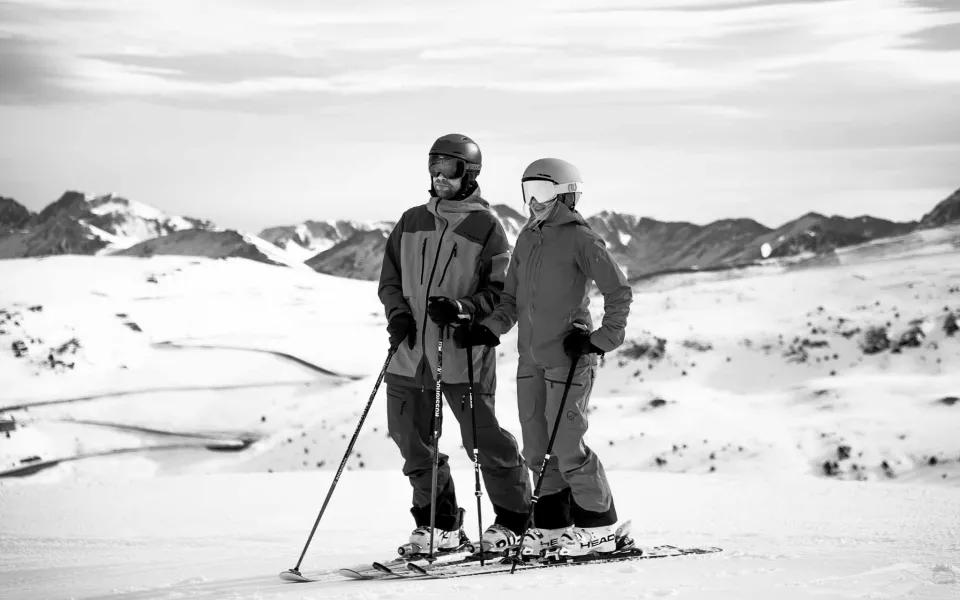
If you’re planning a winter holiday to a ski resort in the near future, you’ll want to start thinking about all the ski equipment you’ll need with plenty of time. Even though the majority of the main pieces of equipment can be rented out at the ski resort, many skiers prefer to bring their own gear since that way they know it fits and suits them perfectly. That makes sense, but it’s important to give yourself enough time to acquire these items, for example shopping for ski poles.
Of all the pieces of ski equipment, ski poles can be among the most complicated to shop for. Firstly, there’s the matter of what do you even call ski poles when searching for them, as they are named ski poles in many countries but called sticks in British English, stocks in Australian English or sometimes just poles in American English.
Furthermore, finding the right ski pole size and ski pole height is a really important part of preparing for a skiing holiday. While choosing the right ski length is also key, many experienced skiers will tell you that getting the poles right is even more significant if you want to have maximum control.
So, to help you navigate the world of ski poles and understand what a ski poles size chart looks like, we’ve put together this ultimate guide to ski poles.
The importance of ski pole sizing: Unveiling the size chart
First things first, let’s address a couple of common questions, which go along the lines of ‘Do ski poles actually help?’ or ‘Is it better to ski with or without poles?’. Well, ski poles definitely help, so long as you have the right ski pole height and so long as they’re used correctly. Jabbing ski poles into the ground in the wrong way is worse than having no ski poles at all, but there are many benefits to good use of ski poles, the main one being the way they can help you to turn more smoothly and, therefore, reduce the strain on your body.
The importance of ski pole sizing cannot be overstated and this is where the ski poles size chart comes in to help. The good news is that the ski poles size chart is super simple and even easier to use than the equivalent for the length of the actual skis. Let’s take a look.
Determining your ideal ski pole size: A step-by-step guide
To calculate the ideal ski pole size and ski pole height for you, the first step is to measure your own height. Then, it’s simply a case of finding the right bracket for you on a ski poles size chart, with a common one outlined right here:
- Skier height of 6'7" and above = 140cm ski pole size
- Skier height of 6'4" - 6'6" = 135cm ski pole size
- Skier height of 6'1" - 6'3" = 130cm ski pole size
- Skier height of 5'10" - 6'0" = 125cm ski pole size
- Skier height of 5'7" - 5'9" = 120cm ski pole size
- Skier height of 5'4" - 5'6" = 115cm ski pole size
- Skier height of 5'1" - 5'3" = 110cm ski pole size
- Skier height of 4'9" - 5'0" = 105cm ski pole size
- Skier height of 4'5" - 4'8" = 100cm ski pole size
- Skier height of 4'1" - 4'4" = 95cm ski pole size
Achieving precision and comfort: Adjusting ski pole height
Of course, the above ski poles size chart is simply an estimation. When you’re picking out your poles, you should pick some up and put them to the ground. It’s a good idea to mimic some of the most common skiing movements you’d actually make out there on the pistes, even if you feel a little silly doing so inside a store.
One other thing to consider is looking into adjustable ski poles, also known as telescopic ski poles because they expand and retract like a telescope. Some consider these to be the best ski poles, because they offer flexibility.
Expert tips and recommendations for choosing ski poles
Why might you need flexibility with your ski poles? Well, it should be noted that the above ski pole recommendations and ski poles size chart are for downhill skiing, typical of a ski resort. But, if you’re going cross country skiing then you’ll also want poles but for different reasons and for a different kind of support. With cross country skiing, you’ll want your ski poles to be a little longer, approximately 20 cm to 30 cm longer. If you’re planning on trying both types of skiing during your next winter adventure, one of the top ski pole recommendations is to opt for adjustable ski poles to save money and space.
As for some other ski pole recommendations, make sure to really check the grip as this is the only part of the ski pole you’ll actually come into contact with. Therefore, it’s vital that it offers a comfortable grip. And, finally, if you can find some ski poles with a strap then that’s ideal too, as it means the pole won’t go flying away if your hand slips off the grip for a moment.
So, now that you’ve read through our ultimate guide to ski poles, it’s time to start browsing and, before long, to start skiing!
